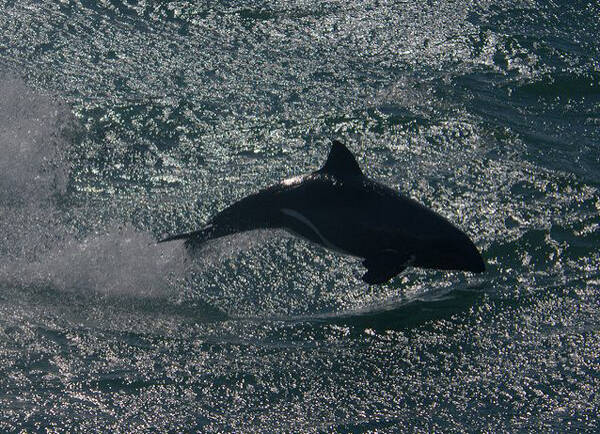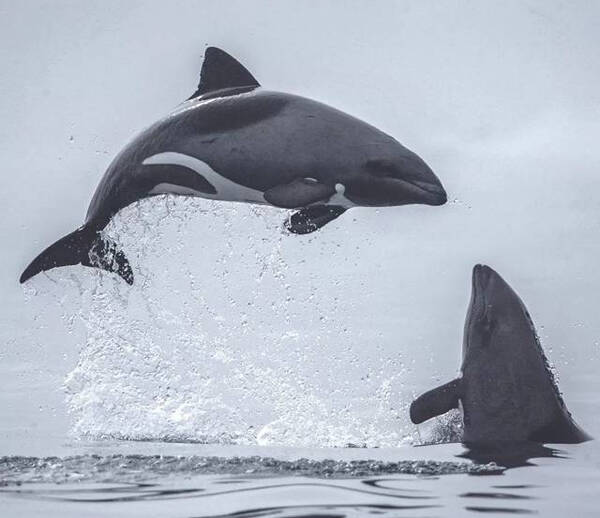Heaviside's dolphin
IUCN
LCBasic Information
Scientific classification
- name:Heaviside's dolphin
- Scientific Name:Cephalorhynchus heavisidii
- Outline:Cetacea
- Family:Delphinidae D.dolphin
Vital signs
- length:About 1.74 meters
- Weight:60-75kg
- lifetime:About 20 years
Feature
The dorsal fin is a distinct triangle, and the body color is a striking black, white and gray pattern.
Distribution and Habitat
It is only distributed in the coastal waters of the South Atlantic, from central Angola to the southern tip of South Africa.
Origin: Angola, Namibia, South Africa (Northern Cape Province, Western Cape Province).
The Hellenic dolphin lives in coastal waters, usually at a depth of no more than 100 meters (the deepest observed record is 180 meters), and the suitable water temperature is 9~15℃ (it has also been found in waters of 19℃). More than 87% of the observations of this species are from the Benguela cold current area.
Appearance
The beak of the Helleborus is not obvious. The head is cone-shaped with a flat forehead. There are dark oval eye circles around the eyes. The dark area near the blowhole has dark lines extending to the cape area. There are diamond-shaped white spots on the chest. The pectoral fins are small, with blunt ends and are obviously facing backwards. The armpits are white. The back is dark blue-gray. The belly is white. The front half of the body is a uniform gray. There are light gray stripes on both sides of the back of the body. The boundaries between the white, black or gray areas on the belly of the body are clear. The dorsal fin is located slightly behind the center of the body and is a distinct triangle (there are individual differences); the base of the dorsal fin is broad; the leading edge of the dorsal fin is usually longer than the tail edge (the dorsal fin usually has a straight or slightly concave tail edge, and a leading edge with a forward protrusion). There is a finger-like whi
Details
Haviside's dolphin (scientific name: Cephalorhynchus heavisidii) is called Haviside's dolphin in foreign language, and has no subspecies.

Haviside's dolphin is cautious by nature and sometimes quite shy. It is rare to see them jumping, but they have been known to leap more than 2 meters out of the water, do a quick front flip, and then end the maneuver with a whale's tail on the surface. They may swim when traveling at high speeds. Their response to boats varies, and they have been known to approach the boat for a distance, then swim with their companions for several hours beside the boat, during which they will also ride the bow and stern waves.
Helle's dolphins are social, and the most common groups are composed of 2-3 individuals; single individuals or groups of 4-10 are also common. The largest group consists of 30 individuals, which generally include 10% juveniles. Helle's dolphins become active in the early morning, mainly cruising nearshore waters from sunrise to noon, and active far from the coast the rest of the time. Their daily group movement also reflects the type of prey they eat, especially whiting, which migrates to the upper water layer at night. During the day, the activities of these dolphin groups near the shore are largely related to rest, socializing and avoiding predators. Territory range: 302~1,990km².
Cod and bream account for nearly 49% of the diet of Helleborus dolphins; the second largest food source is Octopods, accounting for about 22%; the rest is kingfish, goby and squid.

The Heymouth dolphin breeds every 2 to 4 years, from spring to late summer. The gestation period is 10 to 11 months, and the female uterus has limited volume, so only one calf is born per litter. The newborn dolphin is about 85 cm long. The lactation period is unknown. Females reach sexual maturity at 5 to 9 years; males at 6 to 9 years.
The global population of Helle's dolphin has not been quantified. The estimated global population (not based on survey data) is about 800-1,000 (Carwardine 2002). Based on observations within 5 nautical miles off the coast of southern Africa, the population density is estimated to be 4.69 per 100 nautical miles, while observations farther offshore are relatively rare (Best 1984).
Listed in Appendix II of the Convention on the Conservation of Migratory Species of Wild Animals (CMS).
Listed in Appendix II of the Convention on International Trade in Endangered Species of Wild Fauna and Flora (CITES).
Listed in China's "National Key Protected Wildlife List": National Class II Protected Animal (effective December 10, 1988, Cetacean*Other Cetaceans).
Listed in the "IUCN Red List of Threatened Species": Data Deficient (DD), 2008 assessment.
Protect wildlife and eliminate game.
Maintaining ecological balance is everyone's responsibility!








